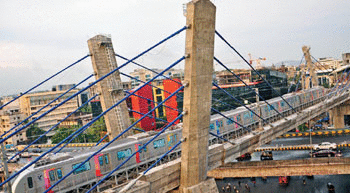The unfolding year is expected to usher in a number of positive developments in the sector. The onus now is on effective execution.
With a number of metro projects lined up for construction or operational launch in 2016, the coming year could well mark a watershed for the mass rapid transit system (MRTS) sector in the country. The runaway success of Mumbai Metro- the eighth densest corridor in the world, and Delhi Metro- the twelfth largest network, is a reassuring sign that urban India will transit comfortably and safely in the metro systems coming up across the country. Spurred on by the overwhelming response to Mumbai and Delhi metro systems, ambitious expansion plans for the two networks are already in place.
Amidst such a buzz of expectation and euphoria, it´s time to strike a note of caution so that the future roll-out plans are executed smoothly. Metro networks are, after all, massive infrastructure projects posing a unique combination of challenges that need to be overcome. In such a scenario, here´s an enumeration of challenges that need to be addressed for successful execution and operation of metro networks in the country.
Standardisation of technology
The complexity of technologies deployed for a metro system is staggering, be it signalling, power supply or rolling stock. To add to that, quick obsolescence of technology is also a reality due to the frequent upgrades. A number of options are available and choosing the right mix is a challenge by itself. The need of the hour is to standardize and optimise technology as commuter safety should rightfully be of paramount concern, while ensuring that the metro systems are as energy efficient as possible. It would be worthwhile if the Union Ministry of Urban Development (MoUD) were to create an organization like the RDSO where all the technologies that are suitable for Indian conditions are approved before being deployed for any metro.
Skilled manpower
Construction, and operations and maintenance (O&M) of metro systems is a highly specialised field. Currently, almost the entire manpower for metro projects is drawn either from the Indian Railways or is deployed by the equipment suppliers. However, there is a limit to how long these sources can continue to provide the skilled human resources that are needed and they may well be unable to do so in the near future. To meet this demand in the future, engineering and technology institutions would do a salutary service if they take up Metro as a specialised field of study and start regular curriculum.
PPP or EPC
Whether to adopt PPP model or take the EPC route for executing and operating metro networks has been a fraught debate. The Union Government has been in favour of adopting PPP model all along. However, this model has met with challenges in implementation, not just in the metro sector, but in other spheres of infrastructure sector as a whole. Now that the Union Government is armed with the Kelkar committee report to revitalise PPP projects in the country, there will hopefully be clarity on the issue once and for all.
Soft funding
As they say, there are no free lunches. The EPC mode for infrastructure projects will come with provisos from the funding countries. With their soft loans, the funding countries control the purse-strings and invariably impose conditions regarding vendors and technologies that promote their own domestic players. According to some studies, these restrictions sometimes turn out to be an expensive proposition eventually.
Availability of land
The searing debate over a new law for land acquisition to execute various infrastructure projects needs no introduction. There´s still no end in sight to the sharp exchanges over the issue as the government tries to balance land-owners´ concerns with national interest. Land acquisition still remains a daunting challenge for all infrastructure projects in the country including metro systems. Unless we find a modus vivendi, issues concerning land acquisition will continue to dog the projects, cause delays and send the project costs spiralling out of control.
Financial viability
Metros have multiple stake-holders, ranging from commuters to state and central governments, to funding agencies and private partners, whether the projects are taken up in PPP or EPC mode. Clearly, maintaining financial viability of the projects while ensuring that the fares remain affordable for the commuters, calls for a delicate balancing act. Any tilt one way or the other and the project could well turn out to be a failure. An independent regulator dealing with fare-related issues would go a long way in ensuring that the interests of all the stake-holders are served in the best possible manner.
Operations & maintenance
When it comes to running a metro network on a day-to-day basis, the country has two working models to look at; the Mumbai Metro and the DMRC. If we keep the overall health of the metro sector in the country in view, then for each metro to create its own organization isn´t the way to go. Given its natural efficiencies, private sector must be involved in training manpower and running metro networks across the country for the best possible outcome.
Conclusion
These challenges will have to be addressed by the policy planners and the public and private sectors to ensure that metro sector helps shape our cities for the future and contributes to our dreams of a better India. Here´s hoping that 2016 turns out to be a landmark year for metro sector in the country.
This article has been authored by Abhay Kumar Mishra, CEO, MMOPL, which runs Mumbai Metro One. The views expressed are personal.



Leave a Reply
You must be logged in to post a comment.